Bone Marrow Stem Cells Reverse Sickle Cell Disease

Share
A revolutionary new procedure for stem cell transplant is reversing the effects of severe adult sickle cell disease. For years, adults suffering from sickle cell anemia have relied on consistent blood transfusions and drug treatments to combat the disorder. Bone marrow transplants can reverse sickle cell, but have so far been restricted to children in the early stages of the disease. That is, until now.
Sickle cell anemia is a congenital blood disorder that affects all races, but is most common to persons with African ancestry, affecting about 72,000 in the US and millions worldwide. Red blood cells normally take the shape of a doughnut without its hole; in the blood of sickle cell patients, the cells assume an abnormal sickle shape. Sickle cells block small blood vessels and inhibit blood flow, which causes debilitating pain, damages organs and increases the risk of stroke. Many of the risks of sickle cell can be mediated through early diagnosis, dietary supplements, and drug treatment. But even with modern treatment, life expectancy for sickle cell patients is 42 in males, 48 in females. Some severe cases are resistant to existent therapies and can cut life even shorter.
Because red blood cells are produced in bone marrow, some high-risk children qualify for marrow transplants from a suitable sibling donor. Like all organ transplants, the procedure carries the danger of immune rejection, and so requires immunosuppressant drugs in addition to radiation therapy to kill diseased marrow. Transplants have been traditionally restricted to children, whose organs are comparably stronger than adults who suffer from the disease. Transplants are rare – there have been about 200 in the past few decades – and are attempted only in children whose disorders are life-threatening.
But a new procedure developed by the National Institute of Health (NIH) and Johns Hopkins University has successfully transplanted marrow to adults, reversing the disorder in 9 out of 10 patients. The new treatment uses significantly less radiation (about one fourth) to kill the patient’s existent marrow, combined with the immunosuppressant drug Sirolimus to reduce the likelihood of transplant rejection. By allowing more of the patient’s own marrow to remain, recovery from the transplant is faster and healthier (patients could previously spend months in germ-free isolation while their immune systems recovered). Thirty months after the transplant, the nine patients with successful transplants are healthy and show no side effects.
Many adults with sickle cell anemia take the drug hydroxyurea to treat the disorder. Hydroxyurea works by stimulating the body to produce a form of hemoglobin normally only found during development in the womb. The production of this hemoglobin type helps to balance the proportion of healthy vs. sickle cells in the blood, and reduces the damage done to lungs, kidneys, and liver (not to mention the risk of stroke). But hydroxyurea doesn’t work for all adult patients, making the prospect of adult marrow transplant a much-needed form of alternative therapy.
Be Part of the Future
Sign up to receive top stories about groundbreaking technologies and visionary thinkers from SingularityHub.


So far, most adult patients who have received marrow transplants have had “full match” donors – siblings with a fully compatible genetic makeup. The chances of a sibling being fully matched are only 25%. But new procedures are expanding the pool of potential donors to “half match” donors, which includes parents and improves the likelihood of a compatible sibling to 75%. That means more sources of transplant marrow, and a better shot at a successful reversal of the disease.
Future research will aim to expand marrow transplants beyond sickle cell patients. Several other congenital blood diseases could conceivably be treated with marrow transplants, including such debilitating disorders as beta-thalassemia. Researchers are currently exploring the emerging possibilities of adult marrow transplants, and will doubtless yield more amazing treatments in coming years.
[image credit: Salisbury Post]
Drew Halley is a graduate student researcher in Anthropology and is part of the Social Science Matrix at UC Berkeley. He is a PhD candidate in biological anthropology at UC Berkeley studying the evolution of primate brain development. His undergraduate research looked at the genetics of neurotransmission, human sexuality, and flotation tank sensory deprivation at Penn State University. He also enjoys brewing beer, photography, public science education, and dungeness crab. Drew was recommended for the Science Envoy program by UC Berkeley anthropologist/neuroscientist Terrence Deacon.
Related Articles

This Light-Powered AI Chip Is 100x Faster Than a Top Nvidia GPU

This Week’s Awesome Tech Stories From Around the Web (Through December 20)

Data Centers in Space: Will 2027 Really Be the Year AI Goes to Orbit?
What we’re reading

